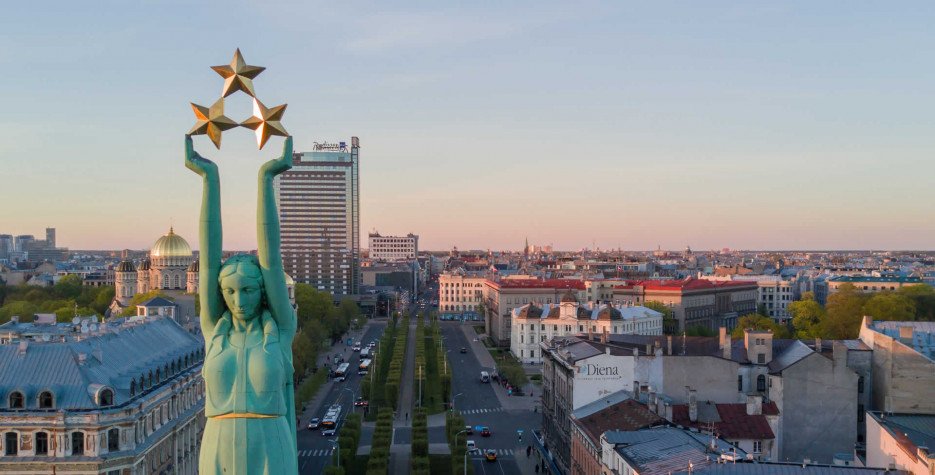
FRANKFURT, GERMANY: Fitch expects Latvia GDP growth of 4% in 2021 due to a stronger performance in 2Q21 than previously expected; and affirmed Latvia’s Long-Term Foreign-Currency Issuer Default Rating (IDR) at ‘A-‘ with a stable outlook.
Latvia’s ratings are supported by a credible policy framework, EU membership and the benefits of eurozone reserve currency flexibility, as well as government debt levels below the median of ‘A’ rated peers.
These factors are balanced by significantly lower income levels and higher net external debt than peers.
The Stable Outlook reflects a degree of confidence that the economy will remain resilient to the ongoing coronavirus pandemic risks and that the authorities will implement policies that are consistent with the long-term sustainability of the public finances.
Fitch now expects Latvia GDP growth of 4% in 2021 (versus 3% at our previous review) thanks to a stronger performance in 2Q21 than previously expected.
Economic output is already above pre-2019 levels (by comparison it took six years for it to recover following the global financial crisis), reflecting a recovery in consumer and investment demand, as well as continued strong performance in export-focussed manufacturing industries.
Government support measures have been instrumental in preventing significant labour market scarring, although sectors such as accommodation and transport are highly likely to suffer permanent losses.
Pandemic-related risks will continue to affect the short-term outlook, with Latvia having vaccinated only around 40% of its total population (versus 56% in the EU), which could force re-introduction of some mobility restrictions in late 2021.
“However, we would expect the impact to be temporary, with domestic demand accelerating from 2022 as pent-up savings are spent and the investment cycle gathers pace,” Fitch Ratings said.
The European Council approved Latvia’s National Recovery and Resilience Plan (NRRP) in June 2021, with a total of EUR1.8 billion (6.2% of 2020 GDP) in grants focused on a series of infrastructure projects, which combined with the normal EU funding cycle will lift headline growth over the medium term. In 2022-2023, we expect growth to average 4.3%.
Latvia’s NRRP centres around a number of reforms to be approved in the next two to three years that aim to tackle long-standing structural issues, including persistent inequality among income groups and regions and long-term productivity and demographic challenges that are relevant to potential growth.
Key reforms include improvement of the healthcare network, a continuation of the administrative/territorial reform, strengthening of law enforcement, the restructuring of the higher education system and a gross minimum income.
If implemented successfully, the programme could help lift longer-term output, leading to more rapid convergence with the peer median, and improving the resilience of public finances.
Fitch expects the 2021 general government deficit to reach 9% of GDP in 2021 (broadly in line with the budget) as this year’s planned Covid-19-support measures with a direct budget impact (6.8% of GDP) are likely to be fully used.
The government has also approved a modest EUR90 million recapitalisation of the national carrier AirBaltic, while other more targeted measures are likely in late 2021 and early 2022 if the pandemic situation worsens.
However, there are few indications that the authorities plan to implement permanent expenditure-raising measures. There has been broad cross-party commitment to (and record of) the stability of public finances, limiting downside risks ahead of October 2022 elections.
“We forecast a gradual reduction of the general government deficit to 4% of Latvia GDP in 2022 and 2.9% in 2023, underpinned by strong nominal growth”.
This would be consistent with public debt/GDP ratio peaking at 49.7% in 2022 (versus the current ‘A’ median of 62.2%). Favourable financing conditions (yields on medium-term external issuance have been at or below 0.1% in 2021) and sound debt management support medium term debt sustainability.
Headline inflation in Latvia has picked up in recent months (to 2.8%yoy in July, versus core inflation of 1.7%) from a low base, reflecting an increase in food and fuel prices, as well as from higher wages. This trend should continue through mid-2022, given projected adjustments to administrative prices and base effects, before moderating thereafter.
In the next couple of years, a combination of strong headline growth, likely bottlenecks in some labour-intensive industries such as construction and still loose monetary conditions could create some risks of overheating, particularly if it translates into persistently high wage increases.
Wage growth remained strong in 2020 and accelerated in 1Q21 (9.5% yoy), while employers have started to highlight labour shortages as an increasing concern.
Latvia’s external accounts remain broadly stable, reinforcing a trend of growing external resilience. The country has maintained external competitiveness despite increasing labour costs, and ongoing deleveraging in the private sector has reduced external imbalances.
“We expect the current account position to deteriorate somewhat in 2021-2023 as recovery in domestic demand lifts import growth, but this will be offset by strong capital account inflows and higher FDI. Latvia’s net external debt position stood at 12.7% of Latvia GDP at end-2020 (the lowest level in 20 years) and we expect it to continue to narrow to 7.3% by 2023, in line with the current peer median”.